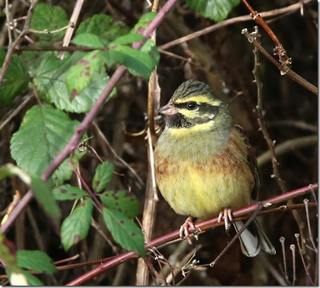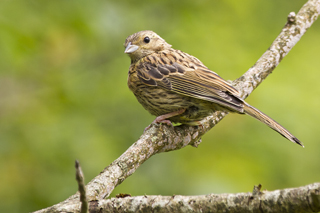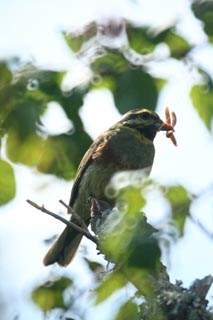Cirl Bunting Update 2014

For those of you who have followed the progress of these little birds over the last few years, you will have seen that their fortunes can at times seem like a game of snakes and ladders. After steady, sustained progress saw their population rise a couple of years ago to over 40 breeding pairs and exceed the target level for the project, along came the dismal, wet summer of 2012 and ground was lost. Thanks to the much-improved summer of 2013, it was hoped that things would get back on track and that the population during 2014 would be comprised of a healthy number of new recruits ready to advance the population again.
As each year goes by, we see fewer of the hand-reared, colour-ringed birds that have been the initial pioneers of the Roseland population, as they naturally die and are replaced by their wild-bred, unringed offspring. This presents us with more of a challenge to accurately assess their numbers, as without coloured-leg rings to identify them individually, one cirl bunting can look pretty much like the next. During the winter there is a tendency to under-estimate the size of the population as birds can overlap in their foraging areas, though once they form pairs and take up their territories in spring, intensive monitoring enables a more accurate picture of their numbers and distribution to be determined.
 With this in mind we were optimistic at the end of what was a particularly wet winter, that plenty of birds had survived and an increase in the breeding population was on the cards. As the weeks went by, established territories from the previous year were occupied, along with a few novel ones to extend the range in a couple of places on the peninsula. By the end of May the previous year’s total of 28 pairs had been exceeded, with plenty of time for others to be discovered. As is usual, the first, early nesting attempts in May almost all ended in failure due to the reduced availability of the insect prey that cirls require to feed their chicks. As temperatures rose and dry conditions persisted, many more pairs than usual successfully fledged broods in June. A continuation of the fine, summer weather right through the following months, enabled an increasing number of broods to be fledged as the parents were able to take advantage of the ideal foraging conditions.
With this in mind we were optimistic at the end of what was a particularly wet winter, that plenty of birds had survived and an increase in the breeding population was on the cards. As the weeks went by, established territories from the previous year were occupied, along with a few novel ones to extend the range in a couple of places on the peninsula. By the end of May the previous year’s total of 28 pairs had been exceeded, with plenty of time for others to be discovered. As is usual, the first, early nesting attempts in May almost all ended in failure due to the reduced availability of the insect prey that cirls require to feed their chicks. As temperatures rose and dry conditions persisted, many more pairs than usual successfully fledged broods in June. A continuation of the fine, summer weather right through the following months, enabled an increasing number of broods to be fledged as the parents were able to take advantage of the ideal foraging conditions.
By the end of the season a total of 39 pairs had produced an impressive minimum of 45 fledged broods, amounting to well over 100 fledglings. This represents a very healthy 39{c8c3b3d140ed11cb7662417ff7b2dc686ffa9c2daf0848ac14f76e68f36d0c20} increase in the breeding population and the highest number of youngsters recorded by a long way, for any of the previous years of the project. The main reason for this success can be attributed to the warm, dry conditions, enabling greater success during the early part of the season and also allowing many more pairs than is usual to produce two fledged broods. Indeed, one particularly industrious pair was successful in fledging three broods – just the second time this has been recorded during the project.
 After reporting on previous breeding seasons of the reintroduced cirl buntings on the Roseland Peninsula, where breeding success has so often been limited, at least in part, by unsuitable weather, it makes a pleasant change to be able to report on one where the weather has not had a significant detrimental impact and has provided the conditions that have led to the most productive year of the project so far. The results also confirm that the mixed farmland habitat on which these birds depend, much of which is managed under Environmental Stewardship by Roseland farmers, is in good condition.
After reporting on previous breeding seasons of the reintroduced cirl buntings on the Roseland Peninsula, where breeding success has so often been limited, at least in part, by unsuitable weather, it makes a pleasant change to be able to report on one where the weather has not had a significant detrimental impact and has provided the conditions that have led to the most productive year of the project so far. The results also confirm that the mixed farmland habitat on which these birds depend, much of which is managed under Environmental Stewardship by Roseland farmers, is in good condition.
With such an encouraging rise in the population coupled with such high productivity this year, it’s likely that the population will continue to rise next year, though as we’ve seen over recent years, the weather will, as always, play a large part in the process.
The cirls will continue to be monitored by our team of staff and volunteers for whom we are, as always, most grateful, just as we are to the Roseland farming community who continue to support our work through Environmental Stewardship.
If anyone has any sightings, or simply wants more information, please feel free to contact me on 07736 792524 or at stuart.croft@rspb.org.uk
Stuart Croft
RSPB Cirl Bunting Reintroduction Project Officer

